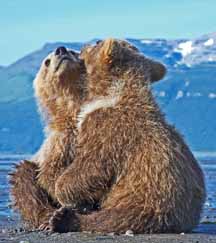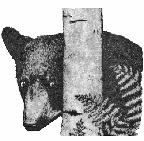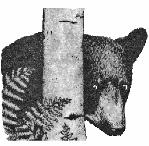____. 1986. Ecosystem perspectives and modeling for Adirondack mammal predator-prey interactions.
58pp. + 48pp. of appendices.
____. 1988. Evolving standards for the legal admissibility and judgement of scientific evidence about
the impacts of human activity on bears or their habitat. Address to the Ninth Eastern Black
Bear Workshop. Ontario. April 1988.
____. 1988. What are "necessary habitat" and "undue adverse effect on the natural environment?"
An ecologist's view of Vermont Acts 250 (8a) and 248 (b5). Prefile testimony presented in hearings
on Champlain (natural gas) Pipeline before the Vermont Public Utilities Board, administrative hearing.
____. 1988. Is the Vermont black bear population crashing? Implications of a population reconstruction
analysis. Prefile testimony presented in hearings on Champlain (natural gas) Pipeline before the
Vermont Public Utilities Board, administrative hearing.
____. 1995. A meta-strategy for world bear conservation.
____. 1996. Buffered viability management of bear populations: a conceptual model for selecting critical
decision thresholds.
____. 1998a. Why abundance of infant litters is not a reliable index of cub recruitment or population status for
Yellowstone grizzly bears (Ursus arctos). [Comments on the USFWS Recovery Plan for the Grizzly Bear.]
____. 1998b. Trends in infant litter abundance among Yellowstone grizzly bears: a response to Boyce et al.
(1998). [Comments on the USFWS Recovery Plan for the Grizzly Bear.]
____. 1998c. Exaggerating size estimates for the Yellowstone grizzly bear population by assuming a constant
proportion of adult females. [Testimony to the USFWS on the Recovery Plan for the Grizzly Bear].
____. 1998d. Does the Grizzly Bear Recovery Plan exaggerate sustainable loss to known-human kills?
[Testimony to the USFWS on the Recovery Plan for the Grizzly Bear].
____. 1998e. Critical deficiencies in information-gathering under the Grizzly Bear Recovery Plan.
[Testimony to the USFWS on the Recovery Plan for the Grizzly Bear].
____. 1999. Assessing importance of specific habitat areas.
[Report to the Kenai Brown Bear Stakeholders Committee] (3 pp.)
____. 2000a. Growth & Viability of the Yellowstone Grizzly Population: Comparison & Critique of Analyses from
Opposing Perspectives. [Testimony to the USFWS on the Recovery Plan for the Grizzly Bear].
____. 2000b. Estimating Extinction Risk for Grizzly Bears or Other Large Mammals: Is Foley’s Model Applicable? (69 pp.)
[Testimony to the USFWS on the Recovery Plan for the Grizzly Bear].
____. 2000c. Critique of Boyce (2000) Metapopulation Analysis for the Bitterroot Population.
[Testimony to the USFWS on the Recovery Plan for the Grizzly Bear].
____. 2000d. Critique of the Draft Conservation Strategy for the Grizzly Bear in the Yellowstone Area. (11 pp.)
[Testimony to the USFWS on the Recovery Plan for the Grizzly Bear].
____. 2006a. Critique of the USFWS (1999) Draft Habitat-Based Recovery Criteria for the Yellowstone Grizzly Bear. (30 pp.)
[Testimony to the USFWS -- submitted regarding proposed delisting of the Yellowstone grizzly bear]
____. 2006b. Are Official Estimates of Yellowstone Grizzly Bear Population Size and Sustainable Mortality Critically Biased
by Annual Variation in Thoroughness of Censusing Adult Females with Infant Cub Litters? (103 pp.)
[Testimony to the USFWS -- submitted regarding proposed delisting of the Yellowstone grizzly bear]
____. 2006c. Overview of my Comments on the U.S. Fish & Wildlife Service DPS-Delisting Proposal For Grizzly Bears (11 pp.)
[Testimony to the USFWS -- submitted regarding proposed delisting of the Yellowstone grizzly bear]
____. 2006d. Crippling Vagueness of the Delisting / DPS Rule. (11 pp.)
[Testimony to the USFWS -- submitted regarding proposed delisting of the Yellowstone grizzly bear]
____. 2006e. Are Yellowstone Grizzly Bears a Distinct Population Segment that is Ready for Delisting? (25 pp.)
[Testimony to the USFWS -- submitted regarding proposed delisting of the Yellowstone grizzly bear]
____. 2006f. Are Delisting Criteria Legal? (2 pp.)
[Testimony to the USFWS -- submitted regarding proposed delisting of the Yellowstone grizzly bear]
____. 2006g. Analysis of Population Trend for Grizzlies (13 pp.)
[Testimony to the USFWS -- submitted regarding proposed delisting of the Yellowstone grizzly bear]
Stringham, S. F. & Bruce McCurtain. 2009. Annual Operating Plan 2010-2019 for Campgrounds and Other
Facilities in Chugach National Forest, Alaska. Alaska Recreational Management. 266 pp. + attachments
More recent reports to be added soon
* Assessed sustainable harvest for the Florida black bear, demonstrating that the Florida Wildlife Commission's
own estimate was several-fold too high.
* Assessed sustainable harvest for the Nevada black bear, demonstrating that the Nevada Department of Wildlife's
own estimate was several-fold too high.
* Assessed bear-human conflict data collected by the BEAR League at Tahoe, demonstrating that diversionary baiting
during the drought of 2007 reduced conflicts by an average of 93% for communities located about 1 km from the
nearest bait station.
* Assessed impacts of human activities, including development of ski areas and a natural gas pipeline,
as well as logging, hunting, angling and wildlife viewing.
* Co-founded and -directed the Blackfeet Environmental Office for the Blackfeet Indian Nation
* Managed a wide range of environmental monitoring under EPA grants for the Blackfeet Nation. *
* Analyzed federal and state environmental laws; drafted Blackfeet tribal environmental legislation.
* Member of the federal team that developed the Polar Bear Habitat Conservation Strategy.
* Researched communication and aggression in bear and ungulate populations.
* Critiqued federal management plans for Threatened grizzly bear populations.
* Modeled single-species and predator-prey population dynamics; analyzed extinction risks.
* Assessed impacts of hunting on bear and ungulate populations.
* Developed interactive educational software relating to wildlife and environmental impacts.
* Critiqued Draft and Final EA’s and EIS’s by other parties.
Services Related to State and Federal Hearings
* Briefied attorneys for Direct and Cross-Examination, and to assist in Discovery and Depositions.
* Testified as an expert witness in Federal (Montana) and State hearings (Vermont, Florida) and before Congressional
subcommittees (Alaska, Montana).
* Conducted cross-examination of opposition witnesses to address questions likely to evoke responses
that were too technical and unpredictable for attorneys to field.
Clients and Cooperators
Corporations
Small businesses
Conservation groups
Government agencies (federal, state, municipal & tribal*).
* Briefied attorneys for Direct and Cross-Examination, and to assist in Discovery and Depositions.
* Testified as an expert witness in Federal (Montana) and State hearings (Vermont, Florida) and before Congressional
subcommittees (Alaska, Montana).
* Conducted cross-examination of opposition witnesses to address questions likely to evoke responses
that were too technical and unpredictable for attorneys to field.
Clients and Cooperators
Corporations
Small businesses
Conservation groups
Government agencies (federal, state, municipal & tribal*).

| Site Visit Counter |
Consulting for Native American Governments/Organizations
* Director, Blackfeet Environmental Office, Blackfeet Indian Nation (1991-93) Co-founded the BEO.
Wrote QA/QC plans, work plans, progress and completion reports, etc; implemented adherence
to environmental laws through programs in water quality (Lakes and Wetlands), air quality, land
quality (e.g., SuperFund; underground storage tanks). Analyzed federal and state environmental
laws; drafted tribal environmental legislation. Served as an expert witness in federal hearings on
environmental impacts.
* Sitka Tribe of Alaska (1995-96).
* Alaska Native Brotherhood (2000-01).
* Director, Blackfeet Environmental Office, Blackfeet Indian Nation (1991-93) Co-founded the BEO.
Wrote QA/QC plans, work plans, progress and completion reports, etc; implemented adherence
to environmental laws through programs in water quality (Lakes and Wetlands), air quality, land
quality (e.g., SuperFund; underground storage tanks). Analyzed federal and state environmental
laws; drafted tribal environmental legislation. Served as an expert witness in federal hearings on
environmental impacts.
* Sitka Tribe of Alaska (1995-96).
* Alaska Native Brotherhood (2000-01).
| Consulting "Making good conservation good business" |
| Halle Fylgare $200 + 4% for editing chapter 13 in Wild Arctic |
| 4% added for handling credit card transactions through PayPal. |

| WildWatch "Making good conservation good business" [email protected] Ph/Fax (907) 260-9059 (Office) 39200 Alma Ave. Soldotna, AK 99669 |


Major Projects (since 1970)
| MAJOR NON-CONFIDENTIAL CONSULTING REPORTS (Not including reports to EPA under their grants program or confidential reports to private clients - some of whom prefer remaining anonymous) |